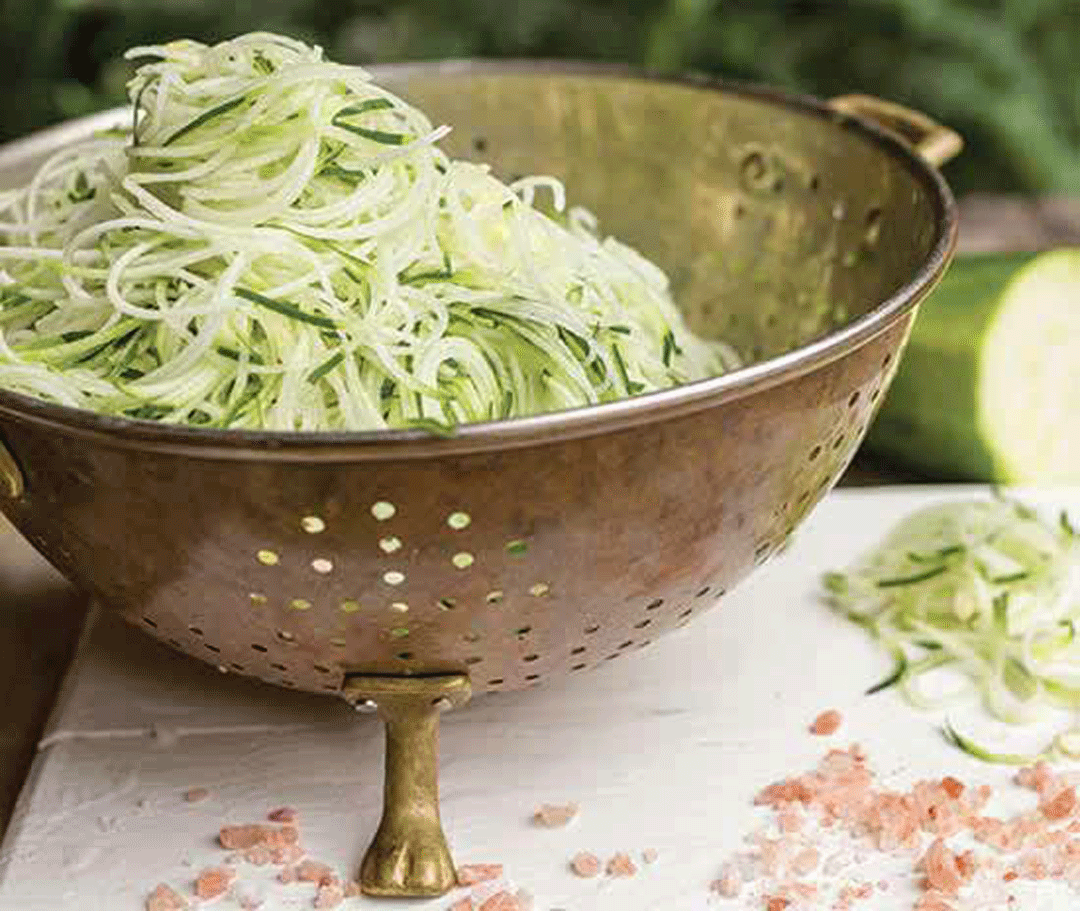 I like to call zucchini noodles “zoodles.” I make a lot of them because I love growing zucchini in my garden, and it does take over! But if you have the space, garden-fresh zucchini is absolutely worth it. One of the tricks to making zucchini noodles is to use zucchini that aren’t too large—no more than 12 inches long and 2 inches wide. The seeds in large zucchini can make a mess out of your spiral slicer. The other trick is to remove some of the water from the zucchini noodles so that the beautiful sauce you’ve made doesn’t become a watery mess when tossed with the noodles. The two easiest ways to do so are to salt and drain the raw zoodles or to dehydrate them in a low-temperature oven (which I prefer).
I like to call zucchini noodles “zoodles.” I make a lot of them because I love growing zucchini in my garden, and it does take over! But if you have the space, garden-fresh zucchini is absolutely worth it. One of the tricks to making zucchini noodles is to use zucchini that aren’t too large—no more than 12 inches long and 2 inches wide. The seeds in large zucchini can make a mess out of your spiral slicer. The other trick is to remove some of the water from the zucchini noodles so that the beautiful sauce you’ve made doesn’t become a watery mess when tossed with the noodles. The two easiest ways to do so are to salt and drain the raw zoodles or to dehydrate them in a low-temperature oven (which I prefer).
Ingredients
How to Make It
- If making baked zoodles, preheat the oven to 250°F. Place a paper towel on a rimmed baking sheet. To Prepare the Zucchini for either Method
- Cut the ends off the zucchini to create nice even edges. If you desire white “noodles,” peel the zucchini.
- Using a vegetable spiral slicer, swirl the zucchini into long, thin, noodlelike shapes by gently pressing down on the handle while turning it clockwise. To Make Baked Zoodles
- Spread out the zucchini noodles on the prepared baking sheet and bake for 20 minutes. Remove from the oven and serve immediately. To Make Salted and Drained Noodles
- Place the raw zoodles in a colander over the sink and sprinkle with the salt. Allow to sit for 5 minutes, then press to wring out the extra water. Serve immediately.
- Zoodles are best consumed as soon as they’re baked or salted and drained, so it’s best to make just the amount you need (though to save time, you can spiral-slice the zucchini in advance; see Tip). If you have leftover prepared zoodles, store them unsauced in an airtight container in the refrigerator for up to 5 days. Freezing is not recommended since the zoodles tend to get soggy.
| Nutrition Facts |
Serving Size 1 |
Nutritional Value Per Serving | Calories 18 kcal Calories from Fat: 1.8 kcal |
|
% Daily Value*
|
| Total Fat 0.2 g 1% |
Trans Fat 0.0 g |
carbohydrates 3.8 g 3% |
Dietary Fiber 1.2 g 3% |
Protein 1.4 g 3% |
* Above mentioned %DVs (Percent Daily Values) are based on 2,000 calorie food intake.
DVs (Daily values) may be vary depending upon individuals daily calorie needs. Above nutritional values are estimates and should only be used as a guide for approximation. They are not allfoodchef.com recommendations. Calculations are based on average weight of 194 lbs. and ages of 19 to 50 years. |
